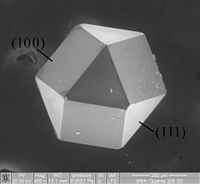
Photo from wikipedia
Recent studies have proven the possibility of polymer sheet forming by incremental sheet forming (ISF) process, while there are limited studies on ISF of polymer matrix composites. Fiber-reinforced polymers (FRP)… Click to show full abstract
Recent studies have proven the possibility of polymer sheet forming by incremental sheet forming (ISF) process, while there are limited studies on ISF of polymer matrix composites. Fiber-reinforced polymers (FRP) are significantly useful in industries due to their unique properties. In the current study, owing to the merits of ISF and the wide applicability of FRP, single point incremental forming (SPIF) of polyamide 6 (PA6) sheets reinforced by glass fibers (GF) is taken into account at various forming temperatures. In this regard, a fixture equipped with a ceramic infrared heating element was designed. The effect of some important parameters such as the volume fraction and orientation of fibers and the forming temperature on the formability, the thickness distribution, and the dimensional accuracy of PA6 and PA6/GF sheets is investigated. According to the results, an improvement in the formability of the composite sheet can be obtained using SPIF by increasing the forming temperature and decreasing the volume fraction of fibers. The formability of the composite sheet with the fiber orientation of [0/90] is far less than the one with unidirectional fibers. In the most of the successfully formed samples, the transverse compaction and the fracture of fibers at the part bottom, the buckling of fibers at the edge of the backing plate, and the draw-in of the sheet along the main direction of fibers can be detected. The thinning of the composite sheet is most affected by the volume fraction and orientation of fibers, while the forming temperature has the least effect. Moreover, the feasibility of SPIF of a circular flange with a wall angle of 90° from the composite sheet is assessed at elevated temperature.
Journal Title: Journal of Thermoplastic Composite Materials
Year Published: 2022
Link to full text (if available)
Share on Social Media: Sign Up to like & get
recommendations!